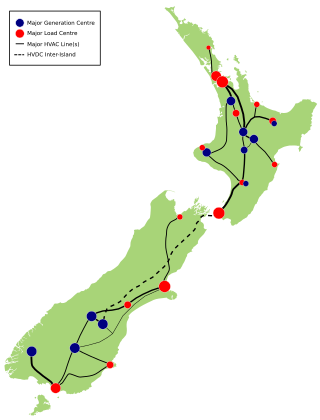The New Zealand electricity market (NZEM) is a decentralised electricity market regulated by the Electricity Industry Participation Code administered by the Electricity Authority (EA). The authority was established in November 2010 to replace the Electricity Commission.

Genesis Energy Limited, formerly Genesis Power Limited is a New Zealand publicly listed electricity generation and electricity, natural gas and LPG retailing company. It was formed as part of the 1998–99 reform of the New Zealand electricity sector, taking its generation capacity from the breakup of the Electricity Corporation of New Zealand (ECNZ) and taking retail customers from three local power boards in the Lower North Island. The New Zealand Government owns a 51% share of the company.
Meridian Energy Limited is a New Zealand electricity generator and retailer. The company generates the largest proportion of New Zealand's electricity, generating 35 percent of the country's electricity in the year ending December 2014, and is the fourth largest retailer, with 14 percent of market share in terms of customers as of December 2015.

Manawa Energy limited is a New Zealand electricity generation company that offers bespoke electricity products to commercial and industrial customers across New Zealand. Manawa energy currently operate 26 power schemes from the Bay of Plenty in the north, to Otago in the south.

Mercury NZ Limited is a New Zealand electricity generation and multi-product utility retailer of electricity, gas, broadband and mobile telephone services. All the company's electricity generation is renewable. Mercury has a pre-paid electricity product sub-brand GLOBUG. Mercury Energy is also the largest electricity retailer in New Zealand.
The Todd Corporation is a large private New Zealand company with a value of $4.3 billion, owned and controlled by the Todd family and headquartered in Wellington, New Zealand. The corporation is currently led by board chair, Nick Olson, and group chief executive officer, Evan Davies. The corporation employs 800 individuals at 10 locations in New Zealand, Australia, and Canada including four on the executive team. The board of directors has seven members.
Powerco is the largest dual-energy distribution company in New Zealand by length, and is one of only two dual-energy distributors in the country.

The Huntly Power Station is the largest thermal power station in New Zealand and is located in the town of Huntly in the Waikato. It is operated by Genesis Energy Limited, a publicly listed company. The station has five operational generating units – three 250 MW coal-and-gas-fired steam turbine units, a 50 MW gas peaking plant, and a 403 MW combined cycle gas turbine plant. The station also plays an important role in voltage support for the Northland, Auckland and Waikato regions.

Wind power constitutes a small but growing proportion of New Zealand's electricity. As of December 2020, wind power accounts for 690 MW of installed capacity and over 5 percent of electricity generated in the country.
The electricity sector in New Zealand uses mainly renewable energy, such as hydropower, geothermal power and increasingly wind energy. As of 2019, 82% of electricity is generated from renewable sources, making New Zealand one of the countries with the lowest carbon dioxide emissions from electricity generation. Electricity demand grew by an average of 2.1% per year from 1974 to 2010 but decreased by 1.2% from 2010 to 2013.

Despite abundant natural resources and a relatively small population, New Zealand is a net importer of energy, in the form of petroleum products. The ratio of non-renewable and renewable energy sources was fairly consistent from 1975 to 2008, with about 70 per cent of primary energy supply coming from hydrocarbon fuels. This ratio decreased to about 60 per cent in 2018. The proportion of non-renewable energy varies annually, depending on water flows into hydro-electricity lakes and demand for energy. In 2018, approximately 60% of primary energy was from non-renewable hydrocarbon fuels and 40% was from renewable sources. In 2007 energy consumption per capita was 120 gigajoules. Per capita energy consumption had increased 8 per cent since 1998. New Zealand uses more energy per capita than 17 of 30 OECD countries. New Zealand is one of 13 OECD countries that does not operate nuclear power stations.

The New Plymouth Power Station (NPPS) was a 600 MW thermal power station at New Plymouth, New Zealand. Located at Port Taranaki, it was dual fuelled on natural gas and fuel oil. Constructed at a time of major hydro and HV transmission developments, it was New Zealand's first big thermal power station planned for continuous base load operation.

Geothermal power in New Zealand is a small but significant part of the energy generation capacity of the country, providing approximately 17% of the country's electricity with installed capacity of over 900MW. New Zealand, like only a small number of other countries worldwide, has numerous geothermal sites that could be developed for exploitation, and also boasts some of the earliest large-scale use of geothermal energy in the world.
The Stratford Power Station is a 577 MW power station located east of Stratford, in Taranaki, New Zealand. The original power station on the site was a 200 MW gas turbine power plant that opened in 1976 and closed in 2001. The current power station comprises a 377 MW combined cycle unit that opened in 1998 and two open cycle gas turbine units for peaking power that opened in 2011. The station is now owned and operated by Contact Energy.

The Ōtāhuhu power station was a power station site located in Ōtara, Auckland, New Zealand. Two plants operated on the site: Ōtāhuhu A and Ōtāhuhu B. A proposed third station, Ōtāhuhu C, was never built. The stations were owned by Contact Energy.
The Te Huka Geothermal Power Station, also known as Tauhara One, is a 23 MW binary cycle geothermal power station situated near Taupō, New Zealand. The power station is operated by Contact Energy.

Hydroelectric power in New Zealand has been a part of the country's energy system for over 100 years and continues to provide more than half of the country's electricity needs. Hydroelectricity is the primary source of renewable energy in New Zealand. Power is generated the most in the South Island and is used most in the North Island.
The Poihipi Power Station is a geothermal power station owned and operated by Contact Energy. It is located on Poihipi Road near Taupō in New Zealand.

The National Grid is the nationwide system of electric power transmission in New Zealand. The grid is owned, operated and maintained by Transpower New Zealand, a state-owned enterprise, although some lines are owned by local distribution companies and leased to Transpower. In total, the national grid contains 11,803 kilometres (7,334 mi) of high-voltage lines and 178 substations.











